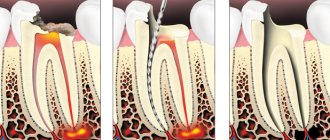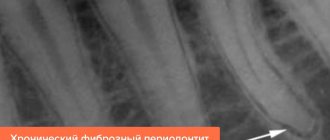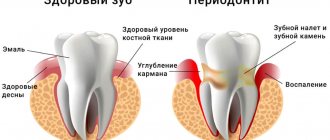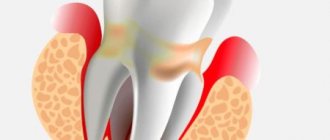Types of chronic periodontitis
Studies of the clinical picture of the possible course of chronic periodontitis and morphological signs made it possible to identify the following types:
- Granulating
With this form of the disease, under a microscope, a noticeable thickening can be observed in the apical part of the tooth root. There is a change in the surface of the periodontium, it becomes uneven. Over time, granulation tissue grows, which causes resorption of bone tissue in the area of inflammation. This process is often accompanied by the appearance of purulent foci, which provokes the appearance of fistulas. In some cases, soft tissue adjacent to the site of inflammation undergoes granulation. This causes the formation of granulomas of various types (submucosal, subperiosteal, subcutaneous), after opening which, fistulas appear on the face and oral cavity, and unaesthetic scars appear at the site of their healing.
Patients experiencing granulating inflammation report pain when chewing solid food, aggravated by pressure, as well as periodic exacerbations of painful conditions.
- Granulomatous
One of the forms of periapical inflammation, characterized by the formation of granulation tissue in the area of the root apex. The maturation of this tissue along the periphery provokes the appearance of a fibrous capsule that degenerates into a granuloma. Depending on the structural features, simple, epithelial and cystic granulomas are distinguished. Quite often, this form of the disease occurs as a consequence of granulating inflammation.
The course of the disease can occur according to various scenarios. Sometimes the granuloma grows slowly or does not grow at all. In this case, it usually does not cause any discomfort and is discovered by chance during an X-ray examination.
In other patients, the granuloma may enlarge, most often coinciding with exacerbations of chronic periodontitis, provoking changes in the granuloma tissue.
- Fibrous
It is characterized by the formation of a limited focus of inflammation caused by the spread of fibrous tissue. Most often this occurs after treatment of the forms of periodontitis described above, but sometimes the fibrous form occurs independently.
Often, fibrous inflammation is accompanied by excessive formation of cement, and in some cases, sclerosis of adjacent bone tissue.
An X-ray examination allows you to determine the form of chronic periodontitis. It is very important to correctly differentiate different types of disease, since the effectiveness of treatment directly depends on this.
Possible causes of pain
After treatment of periodontitis, discomfort may persist for 7-14 days. This is due to injury to the tooth tissue. If you follow the recommendations of your doctor, regeneration will accelerate and discomfort will disappear.
If the pain persists for longer, you should consult a specialist. The main reasons for this problem include:
- poor-quality filling – lack or excess of filling material;
- the presence of foreign bodies in the root canals – most often these are elements of dental instruments;
- the emergence of a new focus of inflammation - due to the spread of pathogenic bacteria, tooth tissue can become inflamed again.
These are the most common causes of tooth pain after treatment. A doctor will help determine the provoking factor.
Causes of chronic periodontitis
In the vast majority of cases, the cause of chronic periodontal inflammation is untreated acute pulpitis. And it, in turn, arises from neglected caries. It is not difficult to guess that the root of all troubles and complications lies precisely in carious spots, which patients tend to ignore.
It is interesting that, unlike most other diseases, periodontitis does not always have an acute stage; in some cases, pulpitis immediately turns into a chronic form of periodontal inflammation, which, without showing itself for a long time, has a destructive effect on the teeth and gums.
Quite often, the chronic stage is still preceded by an acute period of the disease, but many tend to delay treatment, preferring to relieve the pain with medication. As a result, the tooth stops hurting and the patient calms down, but meanwhile the inflammatory process gains momentum, so that later it can express itself fully.
If you do not want to become a victim of chronic periodontitis, then go for a consultation with a dentist as soon as you notice one of the following signs:
- pain that appears when chewing and biting hard foods, as well as pain of a periodic or pulsating nature;
- a feeling of a tooth protruding, preventing you from closing your jaw;
- swelling of the gums and irritation of the oral mucosa in the area of the diseased tooth;
- tooth mobility caused by periodontal destruction;
- the occurrence of one or more fistulas;
- inflammation of the submandibular lymph nodes, observed from the side of the inflammation.
Do not delay visiting your doctor, even if the symptoms are mild.
Symptoms of periodontitis
It is impossible not to notice the symptoms of periodontitis. These include:
- The occurrence of severe pain that is constant;
- The appearance of painful sensations when chewing or touching;
- A clear feeling of which tooth hurts, with a feeling of bursting from the inside;
- Discharge of a small amount of fluid from under the tooth, accumulation of pus in the gums;
- The pain may be throbbing and radiate to the temporal or ear region;
- Bad breath;
- Visible swelling and redness of the gums.
Basic principles of treatment of chronic periodontitis
The choice of treatment methods and means depends on what form of the disease is diagnosed. They can be either conservative or surgical.
The first stage of treatment will be tooth sanitation. During the procedure, the doctor thoroughly cleans the dental canals and tooth cavity, ridding them of carious lesions and infected tissues. Then all cleaned cavities are treated with special antiseptic preparations, and after the doctor is convinced that the inflammatory process has stopped, a permanent filling is placed.
In advanced and complex situations, surgical treatment may be recommended. There is no need to be afraid of this, since doctors always strive to save the tooth by removing only the infected tissue. If therapy is powerless, then resection of the root apex, tooth replantation, cystotomy or cystectomy can be performed. In this case, an effective, but most gentle method is always chosen, which allows you to achieve the desired result while minimizing unpleasant sensations for the patient. Tooth extraction, as a surgical method, is used only in the most extreme cases.
The goal of treatment is to get rid of the infection. To achieve this, the dentist may prescribe:
- Surgical intervention
. The dentist makes a small incision in the abscess, allowing the pus to drain, and then disinfects the area with a special solution.
- Root canal treatment
. This will help eliminate the infection and save the tooth. To do this, the dentist drills into your tooth to remove the diseased central tissue (pulp) and then removes the abscess itself. The root canals are then filled. In this case, a crown can be installed on the tooth to make it stronger, especially for teeth - molars. If you take proper care of your restored tooth, it can last you a lifetime.
- Removal
. If the affected tooth cannot be treated, the dentist will remove the tooth and then remove the abscess to get rid of the infection.
- Antibiotics
. If the infection has spread to nearby teeth, or other areas of the jaw, your dentist will likely prescribe antibiotics to stop further spread. Antibiotics may also be recommended if you have a weakened immune system.
Exacerbation of periodontitis: symptoms and treatment
Most often, chronic periodontitis is detected during exacerbations. It is even often initially mistaken for an acute form, but additional signs revealed by studying x-rays and the patient’s condition make it possible to establish an accurate diagnosis.
The main symptoms of exacerbation of chronic periodontitis are in many ways similar to those observed in the acute form of the disease, and the treatment regimen in both of these cases is the same. It is carried out in several stages.
At the first visit, the doctor opens the pulp chamber and removes the nerve, after which he thoroughly cleans the canals and cavity of the tooth, creating conditions for the outflow of pus. After this, the exposed tooth must be rinsed for several days with a soda solution in order to wash out the remaining purulent masses.
During the second visit, medications are placed into the canals and the cavity of the tooth, which are closed with a temporary filling. The aching tooth is left in this state for 1-2 weeks.
After this, if the control image does not cause alarm, the temporary filling is replaced with a permanent one.
In some cases, exacerbation of chronic periodontitis makes itself felt after completion of treatment. To relieve its symptoms, anti-inflammatory therapy is prescribed, which can be supplemented with physiotherapeutic procedures.
Dental periodontitis: what it is, how to treat it
| Treatment of periodontitis always begins with a doctor analyzing the patient’s complaints and studying the image. Only after this will it be possible to understand whether a tooth will need to be removed due to periodontitis, or whether it can be saved! |
Treatment of periodontitis: stages
- If the disease has reached an acute stage, then the doctor’s first priority is to create an opportunity for the pus to flow out, since otherwise it will not be possible to get rid of the acute pain.
- The crown (if any) is removed, the root canals are unfilled (this must be done on the patient’s first visit).
- If the gums are swollen, the abscess will need to be opened.
Open root canals will allow the pus to drain freely, which will significantly relieve the pain. In addition to this, the dentist will prescribe antibiotics and rinses. A repeat visit is scheduled no earlier than two to three days later. If the pus no longer drains by this point, an antiseptic drug is placed in the canals.
Further methods of treating periodontitis will largely be determined by the size of the inflammatory focus.
Treatment of acute periodontitis of the tooth
The acute stage of the disease is accompanied by severe pain, forcing the patient to consult a doctor as soon as possible.
During the visit, the doctor removes the pulp (the root canals are not closed, since a path is needed for the pus to exit). A crown or filling may need to be removed. If the gums are swollen, the dentist may decide to make an incision to facilitate the release of purulent masses.
In most cases, these measures are enough to make the pain go away. In addition to surgical measures, the patient is prescribed drug therapy in the form of taking oral antibiotics and rinsing with them.
After 4 days, a follow-up visit is scheduled, during which the doctor checks whether all the pus has come out. To achieve final cleaning, an antiseptic is placed into the tooth.
Then, with the help of medications, the inflammatory process is relieved, and the canals are sealed. In some cases, bone tissue restoration and long-term anti-inflammatory therapy may be required. Sometimes a doctor may find it advisable to get rid of a cyst using a laser.
Treatment of chronic periodontitis
Treatment of the fibrotic form involves several visits to the doctor over the course of a week. Since the upper part of the root is not changed, the technique allows you to fill the canals at the next visit to a specialist.
But the treatment process for granulating and granulomatous periodontitis can take a couple of months, especially if there is a complication.
The following procedures are carried out first:
- a picture is taken;
- under anesthesia, carious areas are drilled and access to the canals is provided;
- if the tooth has not been treated, the pulp is removed, if it has been filled, then the canals are unsealed;
- the channels are expanded and treated with an antiseptic solution;
- until the patient’s next visit to the doctor, an antiseptic is placed in the canals (usually Cresophenon is used);
- a temporary filling is placed;
- Anti-inflammatory drugs may be prescribed (but this is not always done).
The next visit is scheduled in three days:
- the previously placed temporary filling and the medicine placed in the canals are removed;
- the channels are thoroughly washed with antiseptics;
- The canals are filled and then a temporary filling is placed again.
On last visit:
- a picture is taken that makes it possible to understand how successful the tooth restoration after periodontitis was;
- The filling material is removed from the canals and treated with an antiseptic;
- the channels are sealed;
- Another picture is taken to determine whether the canals have been sealed to their entire length, otherwise the disease may begin again after some time.
If the size of the cyst exceeds 1.5 cm (cases have been recorded when the formation can grow up to 5 cm), then after filling, root resection and subsequent restoration of the tooth are performed.
Why is chronic periodontitis dangerous?
The anatomical structure of the teeth ensures in most cases the free outflow of serous and purulent masses from the source of inflammation. As a result, the patient may not be aware of the presence of chronic periodontal inflammation for a long time. All this time it is actively developing, exposing tissues to destruction. Sometimes this leads to the fact that it is no longer possible to save the tooth.
In addition to tooth loss, chronic periodontitis leads to the formation of skin or gingival fistulas and various types of granulomas, which require long-term (several months) complex and expensive treatment.
Granulomatous formations pose an additional danger. They can, under the influence of such unfavorable factors as stress or hypothermia, lead to the development of serious inflammatory processes, including sepsis.
Chronic periodontal inflammation can also accelerate the progression of diseases such as nephritis, arthritis and rheumatism, and provoke other health problems.
Mistakes in the treatment of periodontitis
Medical errors acceptable in the treatment of periodontitis, or errors arising for other reasons, can cause complications such as the appearance of a fistula, cyst and osteomyelitis. These complications are called local. But there are also general complications. These include intoxication of the body and infection (sepsis) of the blood. Therefore, to treat a disease such as periodontitis, you should contact only qualified specialists. All complications that arise during the treatment of periodontitis require immediate medical intervention. Let's take a closer look at local complications.
- Fistula. A fistula occurs as a result of poor-quality tooth filling, which causes bacteria to multiply inside it. An inflammatory process appears and a fistula is formed, through which pus is released. Treatment is carried out by taking antibiotics and antihistamines, as well as rinsing with saline solution. If treatment is carried out correctly, the fistula will close on its own.
- Cyst. The formation that occurs in the upper part of the tooth is called a cyst. It develops slowly and does not cause concern. As the size of the cyst increases, complications begin. The cyst is diagnosed using an x-ray and removed surgically using local anesthesia.
- Osteomyelitis. An infectious disease that can lead to the breakdown of the jaw bones. Diagnosis requires a complete examination, including a blood test, x-rays and other tests. For treatment, it is necessary to remove the diseased tooth and then take antibiotics.
It is known that the best prevention of diseases is their prevention. You shouldn’t put off going to the dentist for a long time, even if you have minor caries. Take care of your teeth, and then you will avoid serious dental diseases, have healthy teeth and a beautiful smile.
Prevention of periodontal inflammation
In order not to encounter chronic periodontitis, avoid complications of dental diseases such as pulpitis and caries. Treatment of caries in all cases is much simpler and faster, and it costs much less than the fight against inflammatory processes in the periodontium.
Remember that regular visits to the dentist once every six months can keep your teeth healthy and protect you from large financial expenses in the future.
In addition, strictly observe oral hygiene, using only high-quality toothpastes to brush your teeth, for example, ASEPTA SENSITIVE, which is specially designed to prevent inflammation of the teeth and gums, as well as provide gentle care for sensitive enamel. The carefully selected ratio of enzymes, thermal mud and herbs in its composition ensures maximum therapeutic and prophylactic effect.
ASEPTA mouthwash will also provide invaluable assistance in creating a healthy microflora that prevents the occurrence of periodontitis. Its regular use can significantly reduce the number of pathogenic microorganisms in the mouth, which most often cause infectious inflammatory processes.
Preventive measures also include a healthy diet. Try to eat as many fresh vegetables and fruits as possible, while simultaneously reducing the amount of sweets and carbohydrates in your diet.
Remember that some medications and orthodontic appliances can also have a destructive effect on teeth. Be sure to use additional oral care products while wearing braces and dentures, as well as in cases when you are forced to take medications that are harmful to tooth enamel.
Take full care of your dental health, and they will not make you experience pain and unpleasant emotions.
Why does periodontitis start?
- As we have already noted, most often periodontitis is a consequence of untreated or poorly treated caries and pulpitis.
There may also be other reasons:
- Mechanical trauma and damage to the pulp, in which inflammation develops over time.
- As a complication of periodontal diseases.
- As a complication of rhinitis, sinusitis, osteomyelitis.
- As a consequence of weakening of the body, vitamin deficiency.
- As a concomitant disease with diabetes mellitus.
- As a result of poor oral hygiene and the presence of tartar in the cervical area.
When should you see a doctor?
Have you recently had a root canal treatment? Does your tooth hurt a lot after periodontitis treatment? Do the unpleasant sensations persist? Make an appointment with your dentist. The specialist will conduct a diagnosis and determine the exact cause of the pain syndrome. If errors were made during treatment, the canals will have to be re-processed and filled.
You should also consult your doctor:
- if the tooth loosens easily,
- When closing the jaws and chewing, there is a sharp pain,
- the gums are very swollen, the lip or cheek is swollen,
- body temperature rises to 38-39 degrees,
- health deteriorates significantly.
You should not endure toothache and drown it out with pills. It may indicate pathological processes occurring inside the tooth. You need to see a doctor and get medical help as soon as possible.
The main forms of periodontitis:
- The acute form of periodontitis is accompanied by severe symptoms that occur abruptly and significantly impair the quality of life. In acute periodontitis, a tumor forms on the gums, the patient suffers from sharp and severe pain that is not relieved by painkillers. Urgent comprehensive treatment is required.
The chronic form of periodontitis can occur without any noticeable symptoms. This form of the disease is a logical consequence of an acute form in the absence of dental treatment, but over time it “shoots out” in the form of severe pain, fistulas with purulent contents (abscess due to periodontitis). The chronic form of periodontitis manifests itself in the cold season, during the transition period, when the immune system is weakened. The danger of the chronic form of periodontitis is that the disease occurs with virtually no symptoms, and the patient goes to the hospital for treatment when inflammation reaches its peak and the damaged tooth is almost impossible to save.
To determine whether a patient has acute or chronic periodontitis, it is necessary to perform a diagnosis. For this, a standard examination by a dentist and x-rays are sufficient to visualize the canals, root and periodontium.
Also in dental practice there are several types of periodontitis:
- Granulating - an inflammatory process accompanied by the formation of granulomas (cysts at the base of the root or at its apex);
- Fibrous periodontitis is a disease that is accompanied by fibrous formations when there are no granulomas or cysts with purulent contents. A “lighter” version of periodontitis, which, with the right approach, can be cured in a couple of visits to the clinic to a specialist and cleaning of the canals.
Depending on the cause of periodontitis, there are:
- Mechanical – periodontitis that occurs as a result of trauma to the crown or jaw;
- Infectious – periodontitis resulting from poor-quality fillings in the past, the development of caries, pulpitis;
- Medicinal – periodontitis, which is a complication of taking medications, a consequence of incorrect dental therapy.











